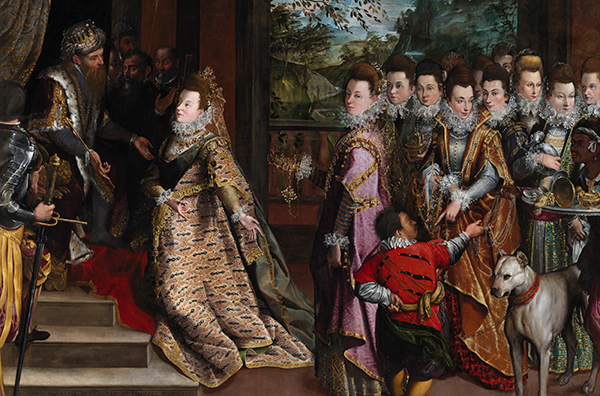THE QUEEN OF SHEBA AT THE NATIONAL GALLERY OF IRELAND
Published in Issue 1 (January/February 2022), News, Volume 30By Marie Bourke
‘A maestra of genres and renowned woman artist of the Renaissance’ is how the curator, Dr Aoife Brady, describes Lavinia Fontana. ‘The Visit of the Queen of Sheba to King Solomon offers a rare glimpse of what this pioneering figure in the history of art could do.’
The origins of the painting are interesting. It was documented in a late eighteenth-century inventory of artworks at the Palazzo Zambeccari, near Bologna’s Basilica di San Paolo Maggiore, where it remained until c. 1850. The Zambeccari were an aristocratic family in whose wider circle Fontana cultivated relationships. In 1859 the painting was purchased by Prince Napoléon Bonaparte (cousin of Napoleon III) for his collection at the Palais-Royal. Following the setting alight of the Palais-Royal in 1871, during the Paris Commune, the painting was rescued and brought to London, where in 1872 the National Gallery of Ireland purchased it from Christie’s.
Born in Bologna in 1552, Lavinia was the daughter of the artist Prospero Fontana, who trained her. A cultured figure, she also gained a doctorate from Bologna University. She married the painter Gian Paolo Zappi, whom she met in her father’s studio. Their working partnership supported her career, allowing her to accept commissions for large and small-scale altarpieces and devotional works, mythological subjects, portraits of the nobility, scholars, religious figures, children and family groups. Zappi cared for their eleven children (only four of whom survived) and acted as Lavinia’s assistant and her agent. Lavinia was regarded as exceptional among women painters and the portraitist of choice for conveying power and status among Bolognese noblewomen. Women artists, including her contemporary Sofonisba Anguissola (1532–1662), excelled against great odds.
The story of the meeting of the Queen of Sheba and Solomon is recounted in two books of the Old Testament. An inscription in the painting translates as ‘The Queen of Sheba came to Jerusalem to test Solomon with difficult questions, and she gave him many great gifts’ (Chronicles II, chapter 9). Traditionally Solomon was the ruler of the biblical kingdom of Israel in 10 BC, and the queen is believed to have come from Saba (Yemen). On learning about Solomon’s God-given wisdom, she travelled to Jerusalem to see for herself, bringing gold, jewels and spices, carried by a retinue of sumptuously dressed woman courtiers and an African servant. Having tested his knowledge, she showered the king with gifts. On her departure Solomon also enriched the queen with lavish gifts.

Above: The Visit of the Queen of Sheba to King Solomon (1599), by Lavinia Fontana (1552–1614). (NGI)
Fontana’s painting has another layer. The monumental biblical-themed canvas appears based on a historical incident also representing members of a sixteenth-century Italian court. The title figures were originally considered to be the Duke and Duchess of Mantua, who between 1587 and 1612 were Vincenzo I Gonzaga and Eleonora de’ Medici. Recent research and discoveries, however, offer new insights into the identity of the characters, suggesting that they represent the Duke and Duchess of Ferrara. In the painting an aged Alfonso II d’Este and his third wife, Margherita Gonzaga, take the key roles in the biblical encounter. The Ferrara were a powerful dynasty, and the marriage enabled a political alliance between the rival houses of Este and Gonzaga. The couple became renowned patrons of art and music.
Records show that the couple passed through Bologna on various occasions, travelling between Rome, Florence, Milan and Venice, when it would have been convenient to have had their portraits painted. It is unclear who commissioned the painting and for what purpose. The attribution to Fontana is undisputed. Her abilities as an artist and her skills across multiple genres are demonstrated in the painting, revealing an educated figure who engaged with biblical and allegorical themes that draw on traditions established by earlier painters. Technical analysis noted changes to the positions of the women’s heads, suggesting that the artist worked on the canvas over some time. Painted in 1599, at the turn of the sixteenth/seventeenth centuries, Fontana’s work shifts away from the mannerism of her father towards greater naturalism and the Baroque. It is a complex, ambitious, potentially masterpiece work, which, following its recent conservation, is on display at the National Gallery of Ireland.
Fontana’s fame spread to Rome, to where she moved in 1603–4, becoming portraitist to Pope Paul V. The first woman accepted into the Academy di San Luca in Rome, together with the rare honour of election to the Roman Academy, she was the first documented female artist to have her own workshop. Fontana died in Rome aged 62. The first large-scale exhibition of her work in two decades—Lavinia Fontana: Trailblazer, Rule Breaker—is scheduled at the National Gallery of Ireland in 2023.
Marie Bourke is a cultural historian, formerly of the National Gallery of Ireland.
















